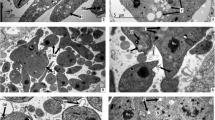Abstract
Treatment with Actinomycin D has been found to induce chromosome breakage in the spermatocytes of the locust. The broken ends appear not to have the capacity to reunite or to restitute. The treatment with this chemical has also been found to affect the development of the potential spermatocytes so that they fail to enter meiosis. The expected meiotic sequence is found to be replaced by a mitotic division. It has been concluded that both chromosomal aberrations and the effect on development of spermatocytes result from disorganization of the synthetic apparatus of the cells.
Similar content being viewed by others
References
Allfrey, V. G., and A. E. Mirsky: Mechanisms of synthesis and control of protein and ribonucleic acid synthesis in the cell nucleus. Cold Spr. Harb. Symp. quant. Biol. 28, 247–262 (1963).
Beadle, G. W.: Further studies in asynaptic maize. Cytologia (Tokyo) 4, 269–287 (1933).
Brown, S. W., and D. Zohary: The relationship of chiasmata and crossing over in Lolium formosanum. Genetics 40, 850–873 (1955).
Hughes, A.: The mitotic cycle: the cytoplasm and nucleus during interphase and mitosis. London: Butterworths Sci. Publ. 1952.
Jain, H. K., and S. L. Basak: Genetic interpretation of chiasmata in Delphinium. Genetics 48, 329–339 (1963).
John, B., and G. M. Hewitt: Karyotype stability and DMA variability in the Acrididae. Chromosoma (Berl.) 20, 155–172 (1966).
Kihlman, B. A.: The production of chromatid aberrations by 5-fluorodeoxyuridine alone and in combination with X-rays and 8-ethoxycaffeine. Caryologia (Firenze) 15, 261–277 (1962).
Koller, P. C.: Asynapsis in Pisum sativum. J. Genet. 36, 275–306 (1938).
Mazia, D.: Biochemistry of the dividing cell. Ann. Rev. Biochem. 30, 669–688 (1961).
Ostertag, W., and W. Kersten: The action of Proflavin and Actinomyoin D in causing chromatid breakage in human cells. Exp. Cell Res. 39, 296–301 (1965).
Rees, H.: Genotypic control of chromosome behaviour in rye I. Inbred lines. Heredity 9, 93–116 (1955).
Reich, E.: Actinomycin: Correlation of structure and function of its complexes with purines and DNA. Science 143, 684–689 (1964).
Stern, H., and Y. Hotta: Regulated synthesis of RNA and protein in the control of cell division. Brookhaven Symp. Biol. 16, 59–72 (1963).
Taylor, J. H., W. F. Haut, and J. Tung: Effects of Fluorodeoxyuridine on DNA replication, chromosome breakage, and reunion. Proc. nat. Acad. Sci. (Wash.) 48, 190–198 (1962).
White, M. J. D.: The effect of X-rays on mitosis in the spermatogonial divisions of Locusta migratoria L. Proc. roy. Soc. Lond. B 119, 61–84 (1935).
Author information
Authors and Affiliations
Rights and permissions
About this article
Cite this article
Jain, H.K., Singh, U. Actinomycin D induced chromosome breakage and suppression of meiosis in the locust, Schistocerca gregaria. Chromosoma 21, 463–471 (1967). https://doi.org/10.1007/BF00336953
Received:
Issue Date:
DOI: https://doi.org/10.1007/BF00336953




